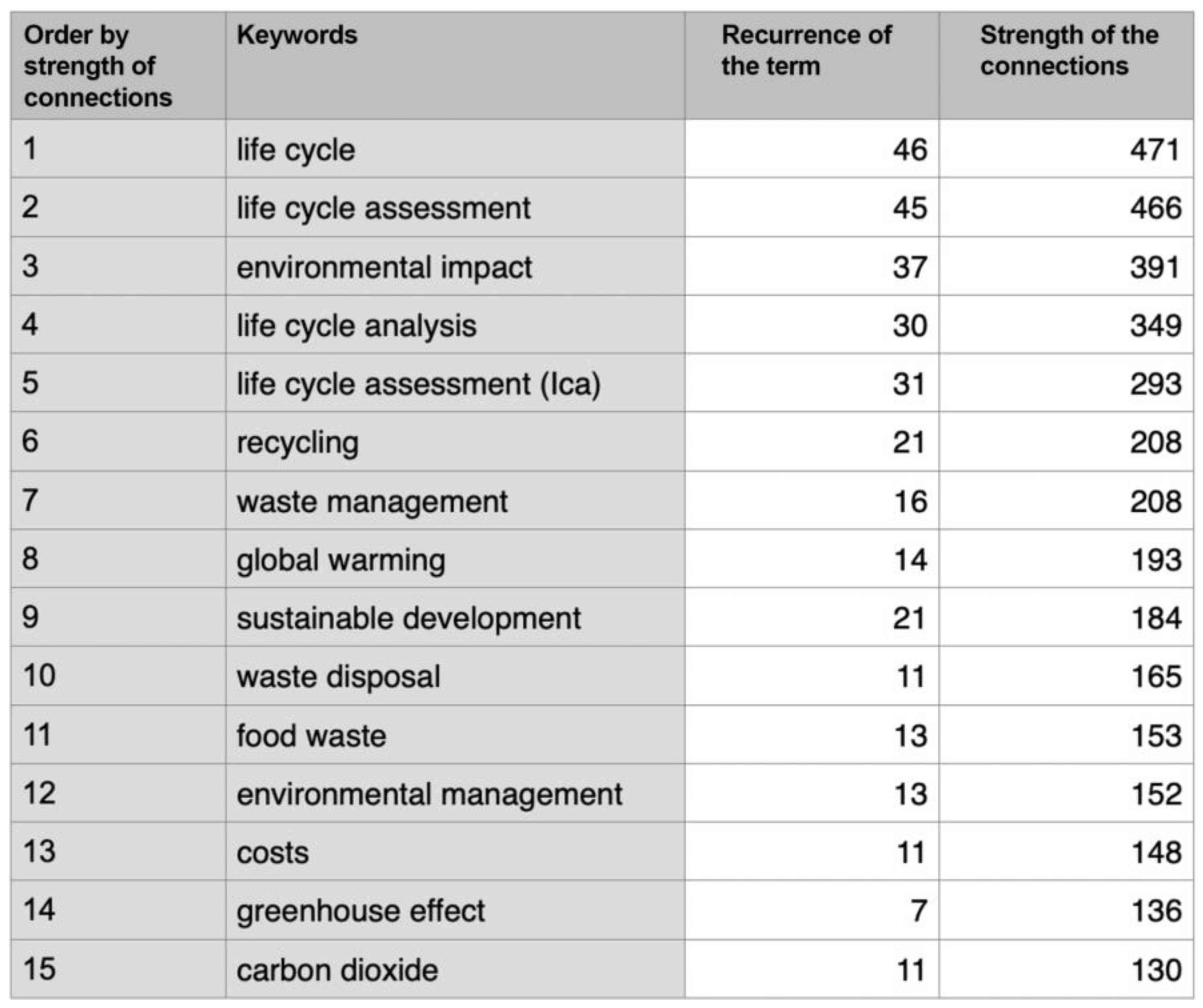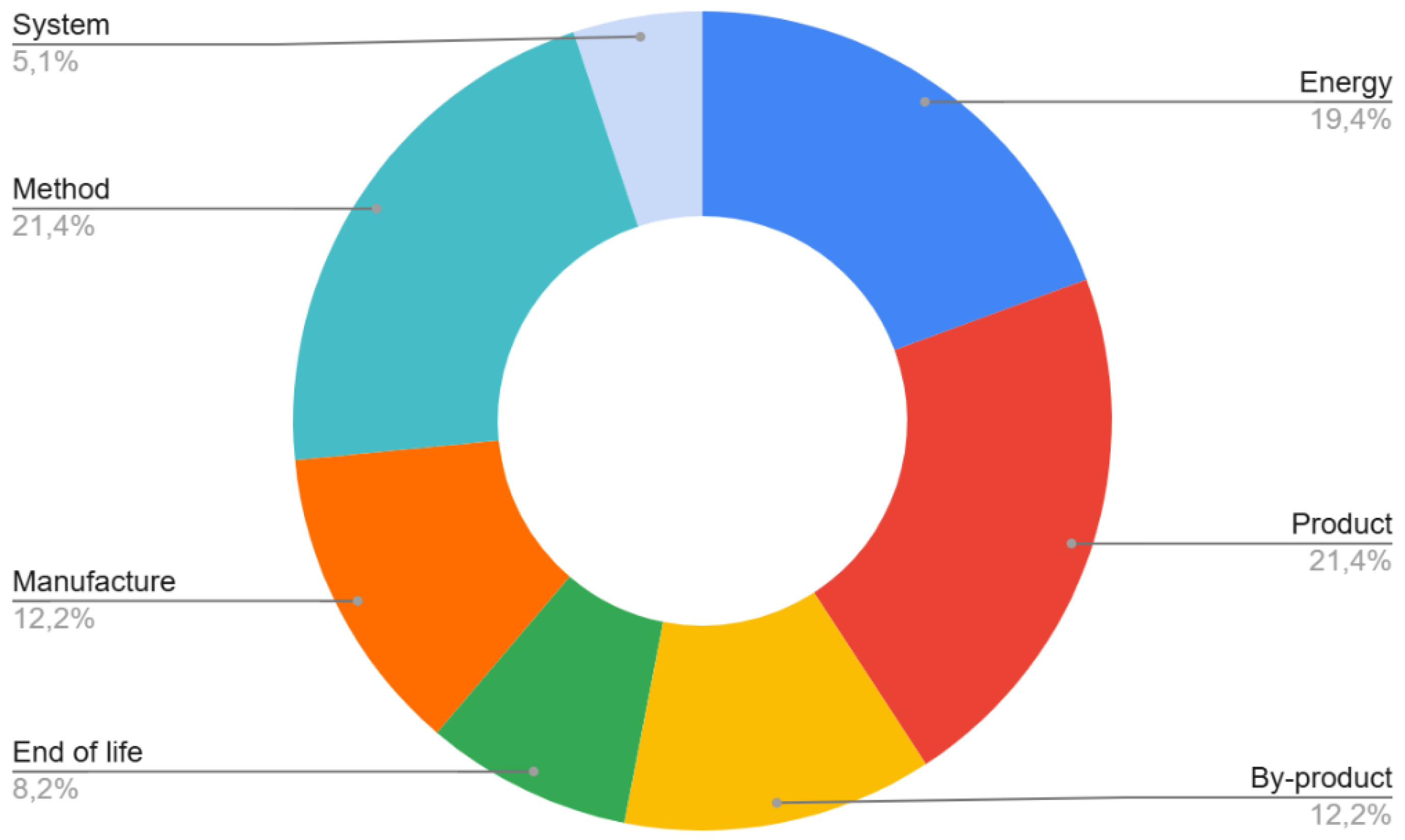Submitted:
24 September 2024
Posted:
24 September 2024
You are already at the latest version
Abstract
Keywords:
1. Introduction
2. Materials and Methods
2.1. Life Cycle Approaches
- Conventional LCC: in the analysis of all costs related to a product's life cycle that are directly the responsibility of the primary producer or primary user during the product's life cycle.
- Environmental LCC: the assessment of all costs related to a product's life cycle that are directly assumed by one or more participants in the product's life cycle
- Societal LCC: assessment of costs associated with the entire life cycle of a product, which is the responsibility of all individuals in society, both in the current period and in the long term.
2.2. Systematic Literature Review: Methodology
- visualise citation networks between different articles or authors, observing connections and influences between scientific papers;
- identify thematic clusters by investigating related research areas and groups of articles covering similar topics;
- analyse keywords to better understand prevailing themes and areas of interest;
- explore and graphically represent the information in the bibliographic data to identify trends, connections and research patterns within the subject area.
3. Results
3.1. Bibliographic Portfolio (BP)
- topics not relevant to the scope of the research, such as LC methodologies applied to the study of food supply chains, water management and treatment, chemicals, plastics and non-natural fibers;
- methodological approaches applied to the evaluation of waste management and collection;
- topics that are inherent but address neither the model definition of the LC approach nor the application of the approaches.
3.2. Scientific Publications Over Time
- a first phase from 2005 to 2007 characterised by a small number of publications (total No. 1) and an absence of research-related scientific production in 2006 and 2007;
- a second phase from 2008 to 2016, in which there was a development of scientific production (No. 28) with peaks of publications in 2011 and 2013 (+27% compared to phase I);
- a third phase between 2017 and 20231, which sees a scientific deepening of the review topics and an increase in the number of publications (73 total) (160.7% increase over phase II).
3.3. Research Journals
3.4. Results Interpretations VOSviewer
- red colour, associated with the “Life Cycle” theme, deals with issues related to waste recycling, with particular attention to the implications on environmental impacts, declining further toward energy valorisation processes;
- green colour, related to the “Life Cycle Assessment” theme, is related to environmental issues, focusing more on impact categories;
- blue colour, assigned to the “Recycling” theme, addresses issues related to waste recycling;
- yellow colour, identified with the “Waste Management” and “Cost” themes, deals with impacts concerning the economic value of waste.
- facilitating the reading of clustered content;
- facilitating the management of complex information;
- facilitating interpretation of the data;
- providing a conceptual framework;
- facilitating the possibility to implement data during the research activities
- ‘energy’, includes a wide range of aspects related to the production, transformation, distribution and use of energy;
- ‘product’, refers to a specific product, its use and/or development within a business, industrial or commercial context;
- ‘by-product’, refers to the production of a result and/or product that is obtained as a consequence of a main process or activity to obtain added economic value;
- ‘end of life’, includes all those studies in which processes are analysed up to the end of a product's life without investigating its subsequent management;
- ‘manufacture’, refers to the process of producing goods or products through the transformation of raw or semi-finished materials using specific equipment and techniques;
- ‘method’, includes scientific production that describes the application of one or more evaluative approaches to issues that are also outside the subject of the research but methodologically significant (e.g., LCA, S-LCA, LCC etc.);
- ‘system’, refers to a set of interconnected components working together to achieve a common purpose.
- ‘fashion and furniture’, is a category used for publications that are particularly focused on the research topics (“Made in Italy Circolare Sostenibile” - MICS);
- ‘fibers’ category that identifies the project “Circular Design for Natural fibers”(CD4NF)
- ‘wood’, is the category chosen for articles that have wood-based products as the subject of the research;
- ‘waste’, groups all articles that investigate the treatment and management of waste from different supply chains;
- ‘food’, includes all articles investigating food products;
- ‘others’, identifies selected articles in the BP that do not have as their object of analysis products, systems, and services that fall under the above categories but have topics of more general interest for the MICS project, for example topics related to biofuels.
- the research ranges between pre- and post-consumer textile waste, natural fibers and bio-composites;
- most of the articles are applicative, i.e., they involve the application of an evaluative approach according to the relevant methodological framework;
- the articles involve a comparative study between several products or focus on a single product/service;
- the functional units appear highly diversified from each other and specific to each evaluative study, leading to criticality in a possible future comparative analysis;
- the calculation of indicators is not uniformly present among different articles. In this regard, several methodologies can be found, the most popular for LCA being the ILCD, ReCiPe, and CML methods. In cases where no preferred method is highlighted, individual indicators are given in full. The evaluation of costs considers different types at a given life cycle stage. No specific indicator calculation methods are given in the S-LCA;
- the most consulted databases for environmental assessment appear to be Ecoinvent and Gabi, but frequently, studies have found it necessary to supplement inventory analysis with primary data from the literature. In addition, referring to a general analysis of the BP, it appears that the most widely used database for S-LCA analysis is PSICLA, which carries the name of the software in which it is used;
- as for the software used for the environmental assessment method, these is SimaPro and OpenLCA. For LCC, the cost analysis provides a specific quantification for each case study, with no references related to databases and software;
- regarding the life cycle taken into account by the different studies, this appears to be variable: some research considers the entire life cycle (from cradle to cradle, A1-D), but most analyses only the production phase (from cradle to gate, A1-A3).
4. Discussion
- the absence of a regulatory framework for S-LCA, LCSA;
- the difficult applicability of the approaches to sectors other than construction and to different product, process and system levels;
- the limited presence of benchmarks, which causes researchers to frequently develop comparative analyses with Business As Usual (BAU) products;
- the site-specific aspect of LC analyses due to supply chain fragmentation (geographic location, local regulations, energy systems, etc...).
5. Conclusions and Future Outlooks
Author Contributions
Funding

Conflicts of Interest
| 1 | The results of the work package related to the analyzis of the state of the art was finished in November 2023, therefore the BP represents a time frame from 2005 to the date of the delivery of the work package. During the next phases of the research new results emerge and therefore will be integrated and considered for future phases of the research MICS project (duration 2023 – 2025). The Figure 5 shows this integration. |
References
- European Commission. Joint Research Centre. Safe and Sustainable by Design Chemicals and Materials :Review of Safety and Sustainability Dimensions, Aspects, Methods, Indicators, and Tools.; Publications Office: LU, 2022.
- Sala, S.; Farioli, F.; Zamagni, A. Life Cycle Sustainability Assessment in the Context of Sustainability Science Progress (Part 2). Int. J. Life Cycle Assess. 2013, 18 (9), 1686–1697. [CrossRef]
- Thiebat, F. Life Cycle Design: An Experimental Tool for Designers; PoliTO Springer Series; Springer International Publishing: Cham, 2019. [CrossRef]
- UNEP. Guidelines for Social Life Cycle Assessment of Products and Organization 2020.; United Nations Environment Programme (UNEP), 2020.
- Hunkeler, D.; Lichtenvort, K.; Rebitzer, G. Environmental Life Cycle Costing, 0 ed.; CRC Press, 2008. [CrossRef]
- Fregonara, Elena. Valutazione Sostenibilità Progetto. Life Cycle Thinking e Indirizzi Internazionali., 1st ed.; Franco Angeli, 2015.
- Guinée, J. Life Cycle Sustainability Assessment: What Is It and What Are Its Challenges? In Taking Stock of Industrial Ecology; Clift, R., Druckman, A., Eds.; Springer International Publishing: Cham, 2016; pp 45–68. [CrossRef]
- Kloepffer, W. Life Cycle Sustainability Assessment of Products: (With Comments by Helias A. Udo de Haes, p. 95). Int. J. Life Cycle Assess. 2008, 13 (2), 89–95. [CrossRef]
- Valdivia, S.; Ugaya, C. M. L.; Hildenbrand, J.; Traverso, M.; Mazijn, B.; Sonnemann, G. A UNEP/SETAC Approach towards a Life Cycle Sustainability Assessment—Our Contribution to Rio+20. Int. J. Life Cycle Assess. 2013, 18 (9), 1673–1685. [CrossRef]
- (Guinée, J. B.; Heijungs, R.; Huppes, G.; Zamagni, A.; Masoni, P.; Buonamici, R.; Ekvall, T.; Rydberg, T. Life Cycle Assessment: Past, Present, and Future. Environ. Sci. Technol. 2011, 45 (1), 90–96. [CrossRef]
- Zamagni, A.; Reale, F. ES-LC e Patrimonio Naturale Life Cycle Analisi Ambientale e Sociale Di Un’area Protetta - Capitolo 2 Approccio Life Cycle e Valutazione Della Sostenibilità; Firenze University Press., 2015.
- Azevedo, S. G.; Santos, M.; Antón, J. R. Supply Chain of Renewable Energy: A Bibliometric Review Approach. Biomass Bioenergy 2019, 126, 70–83. [CrossRef]
- La Rosa, A.D. et al. (2013) 'Life cycle assessment of a novel hybrid glass-hemp/thermoset composite,' Journal of Cleaner Production, 44, pp. 69–76. [CrossRef]
- Gounni, A. et al. (2019) 'Thermal and economic evaluation of new insulation materials for building envelope based on textile waste,' Applied Thermal Engineering, 149, pp. 475–483. [CrossRef]
- Gkoloni, N., Golonis, Ch. and Kostopoulos, V. (2022) 'Integration of LCA and LCC for decision making in biocomposite production,' IOP Conference Series, 1123(1), p. 012071. [CrossRef]
- Ead, A.S. et al. (2021) 'Life cycle analysis for green composites: A review of literature including considerations for local and global agricultural use,' Journal of Engineered Fibers and Fabrics, 16, p. 155892502110269. [CrossRef]










Disclaimer/Publisher’s Note: The statements, opinions and data contained in all publications are solely those of the individual author(s) and contributor(s) and not of MDPI and/or the editor(s). MDPI and/or the editor(s) disclaim responsibility for any injury to people or property resulting from any ideas, methods, instructions or products referred to in the content. |
© 2024 by the authors. Licensee MDPI, Basel, Switzerland. This article is an open access article distributed under the terms and conditions of the Creative Commons Attribution (CC BY) license (http://creativecommons.org/licenses/by/4.0/).




